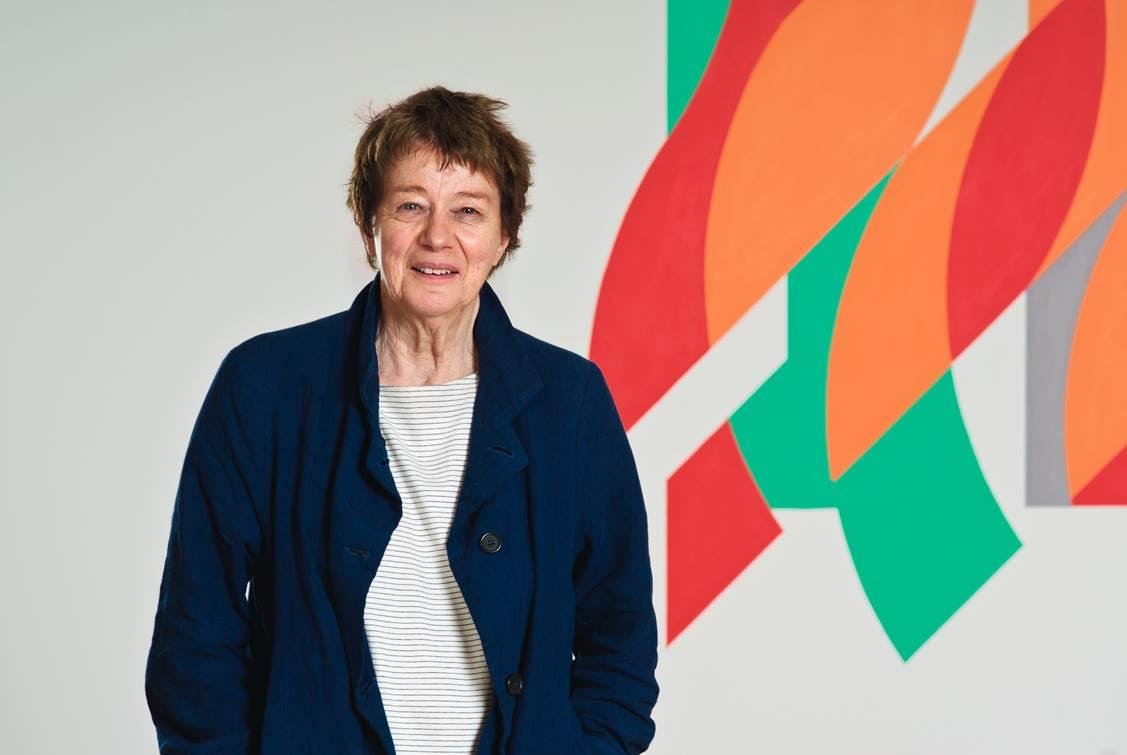calor COLOR
calor COLOR
SOLO SHOW: Anish Kapoor
DUO: Bridget Riley, Adrien Lucca
DUO: Lucas Simões, Blanca Muñoz
GRAPHICS: Herbert Bayer, Piero Dorazio, Beverly Pepper, Jesús Rafael Soto
Marlborough Madrid presents a project developed in different spatial modules and whose axis gravitates around the role played by color in the works of nine international artists. The exhibit opened on the 25th of November this year.
Although these works are diverse in content and structure, each one uses color to claim its space through its “vivacity”, an expression used by Goethe to refer to the fact that refined people avoided bright colors in their clothes and objects and seemed inclined to banish them altogether. He went so far as to assert that only savage nations, uneducated people, and children retain a taste for vivid colors. Walter Benjamin also wrote about the child’s relationship to color by differentiating their perception of color from that of the adult: he even suggested that the latter understood color as a layer superimposed on matter, to such an extent that they regarded it as a deceptive cloak. Perhaps this deception could be linked to the names of synthetic colors that create a phantasmagorical and ethereal aura, makingit is difficult to imagine a color by its name alone. Far from being misleading, the vivacity of the colors of the works in this exhibition is symptomatic of the fact that calor [heat] and color, following the free etymological relationship of Isidore of Seville, are fundamentally composed of the same matter.
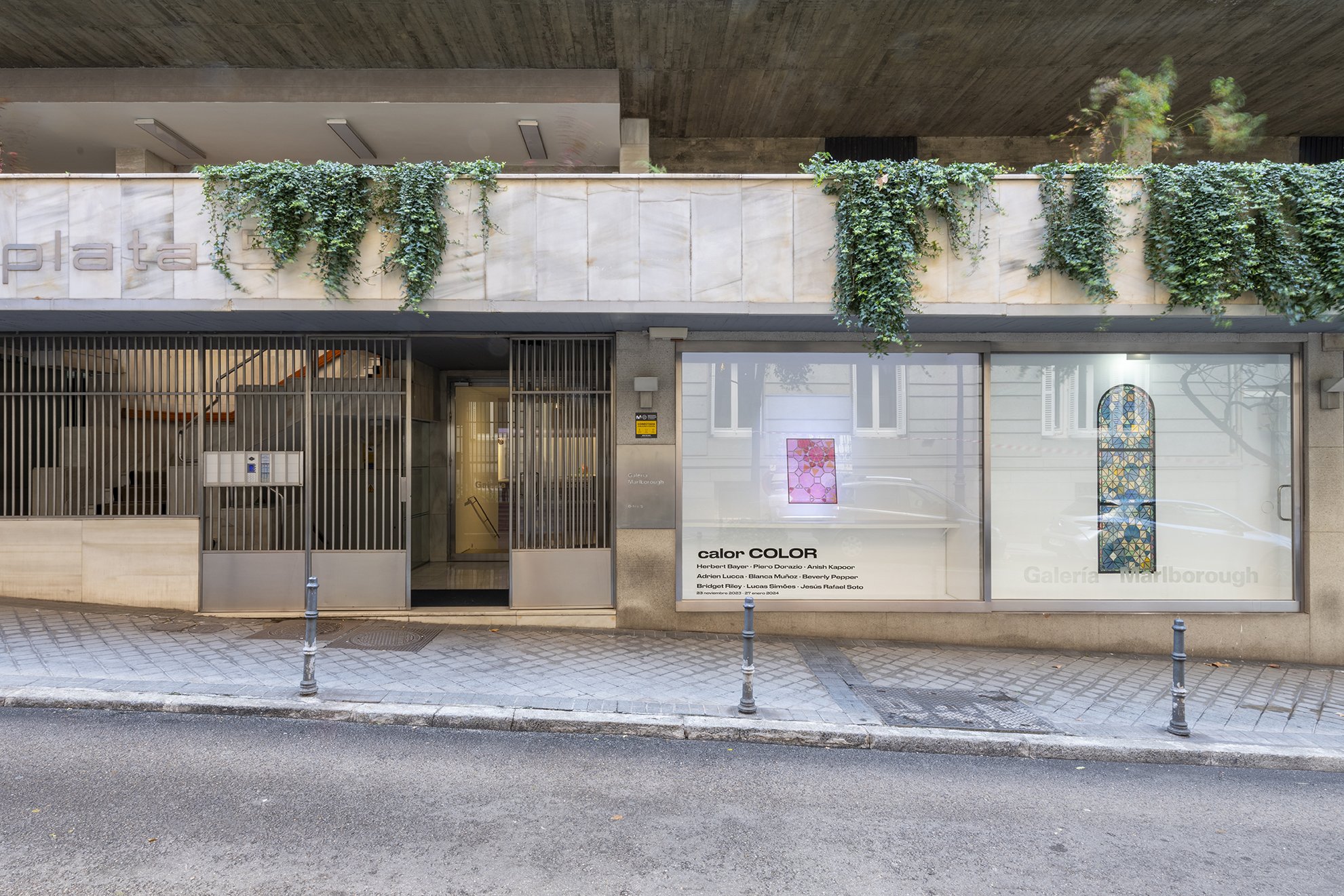


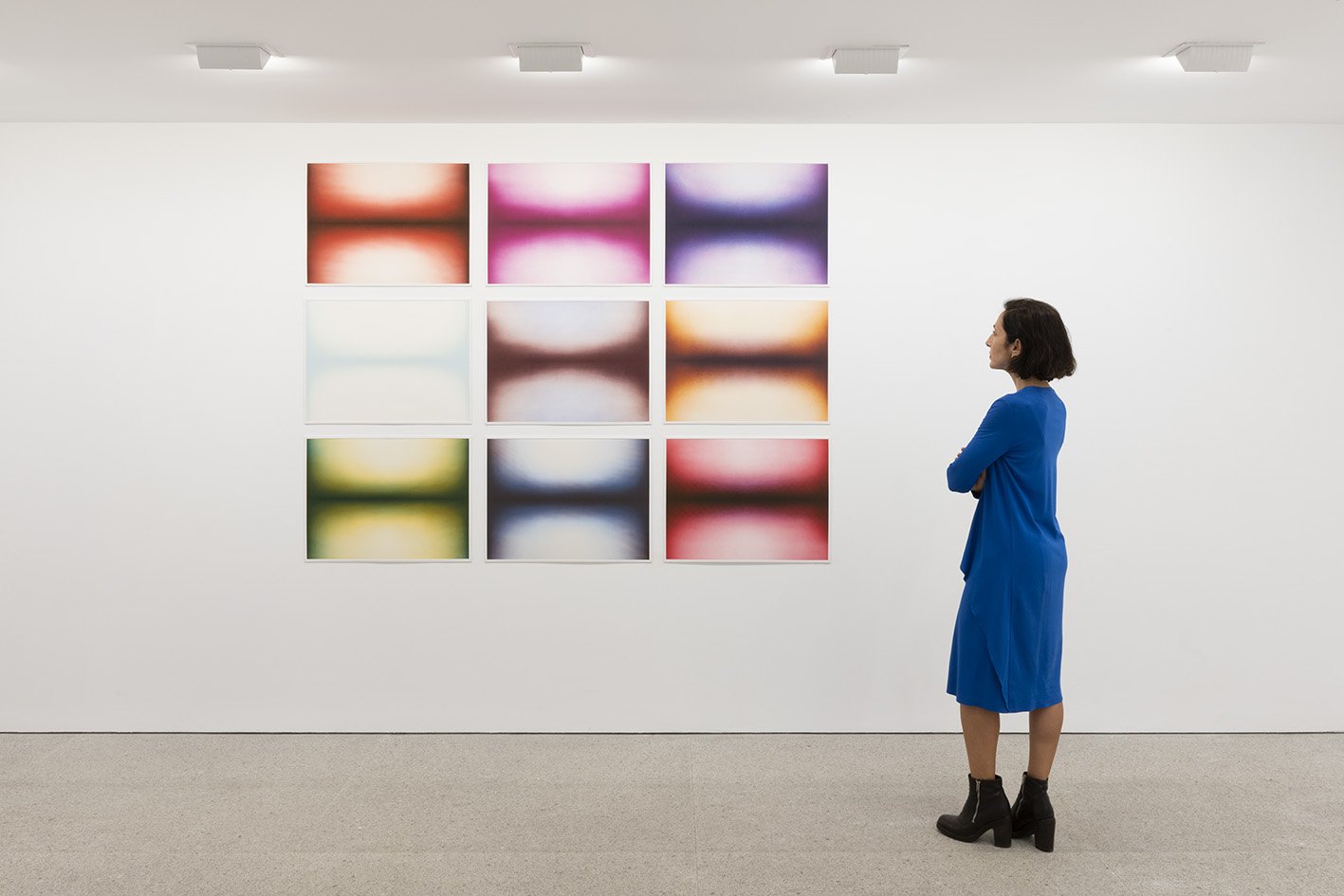






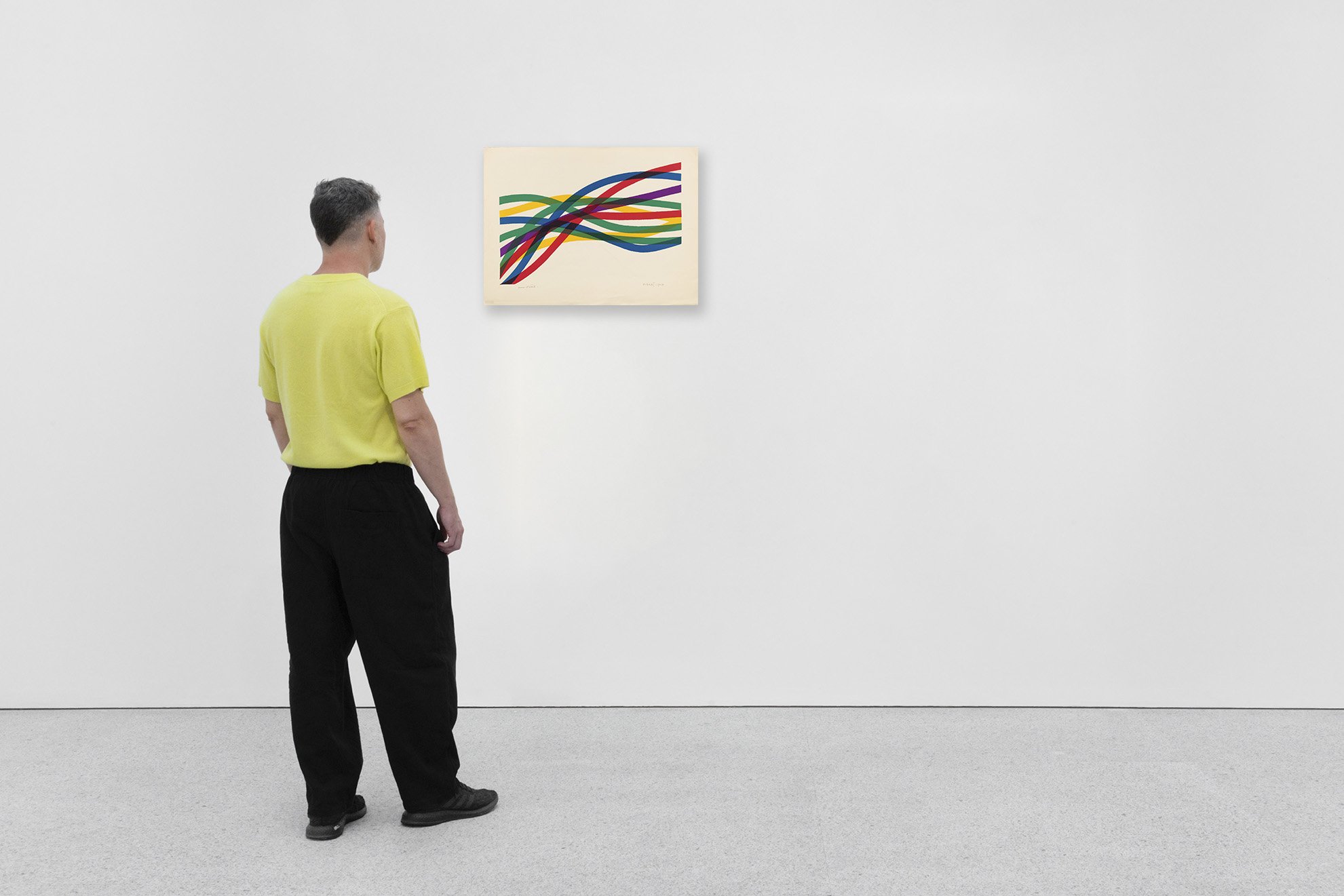
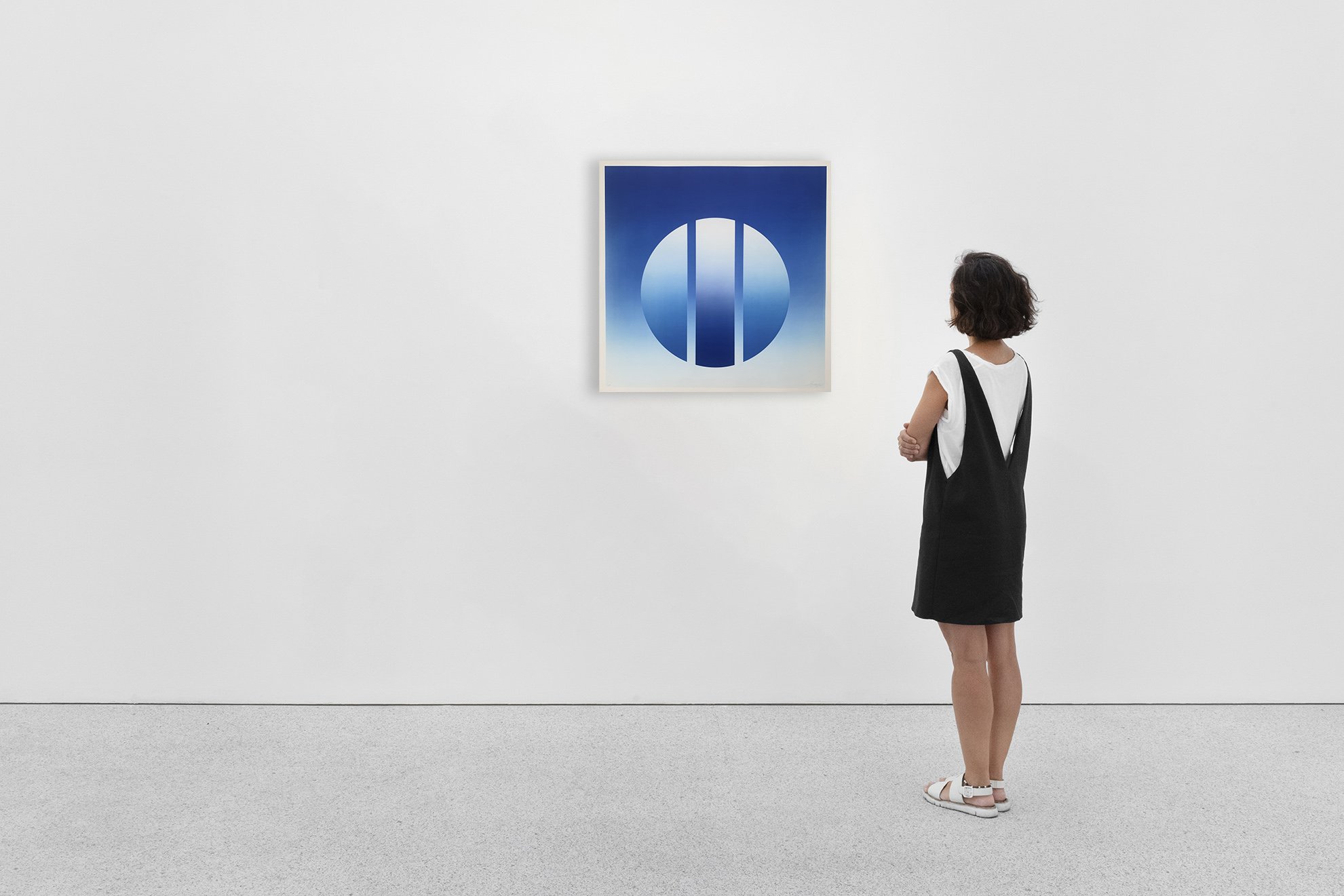



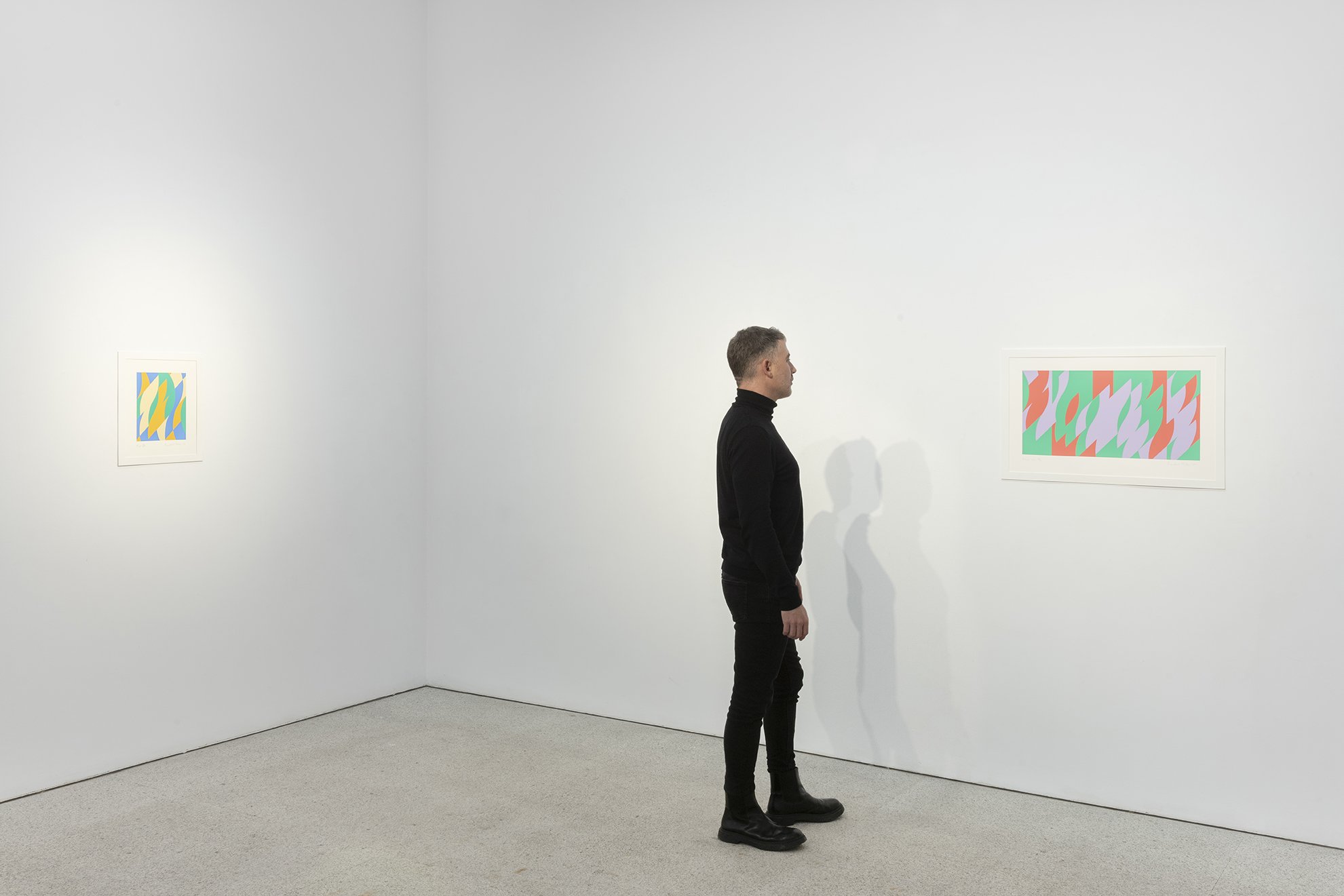
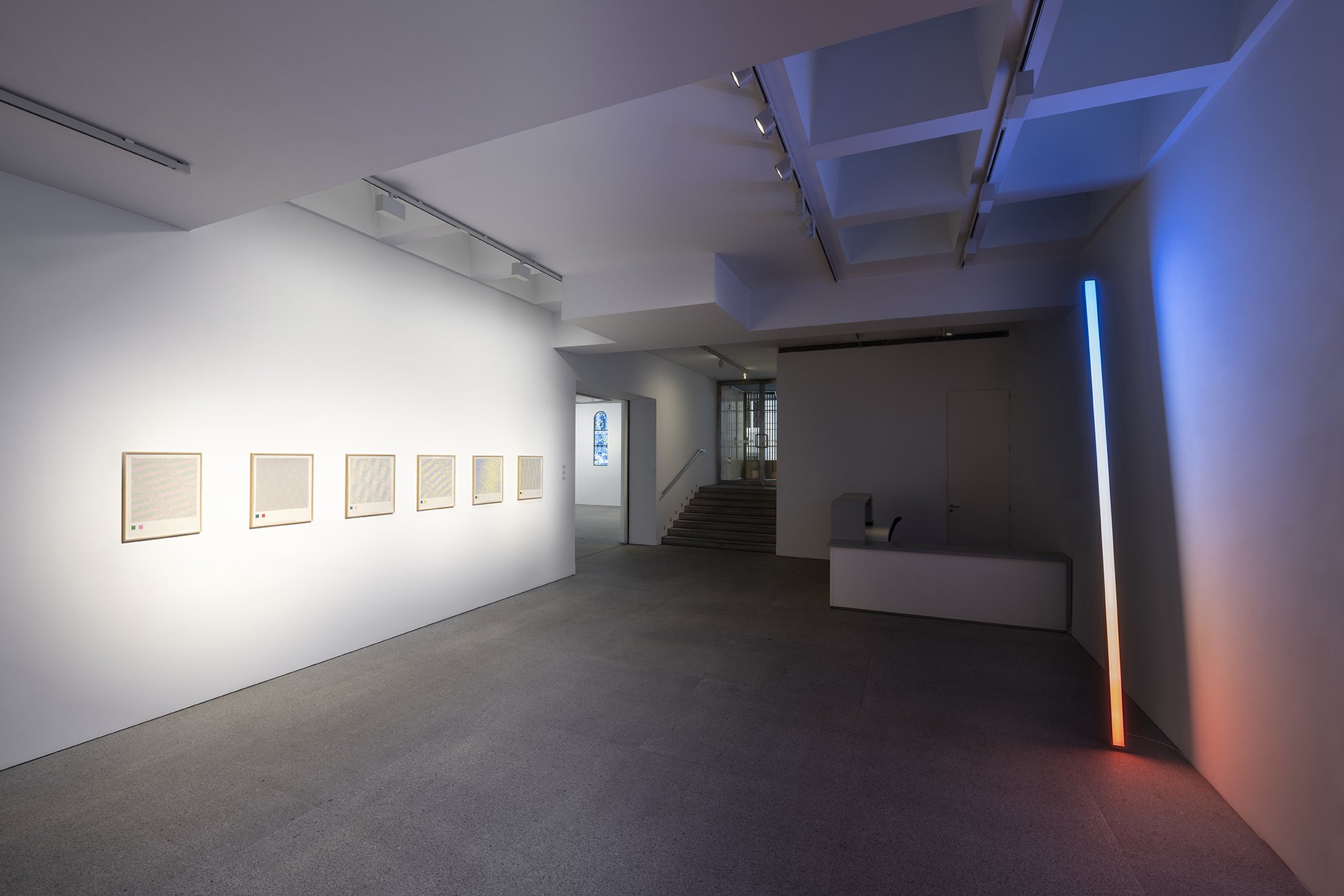

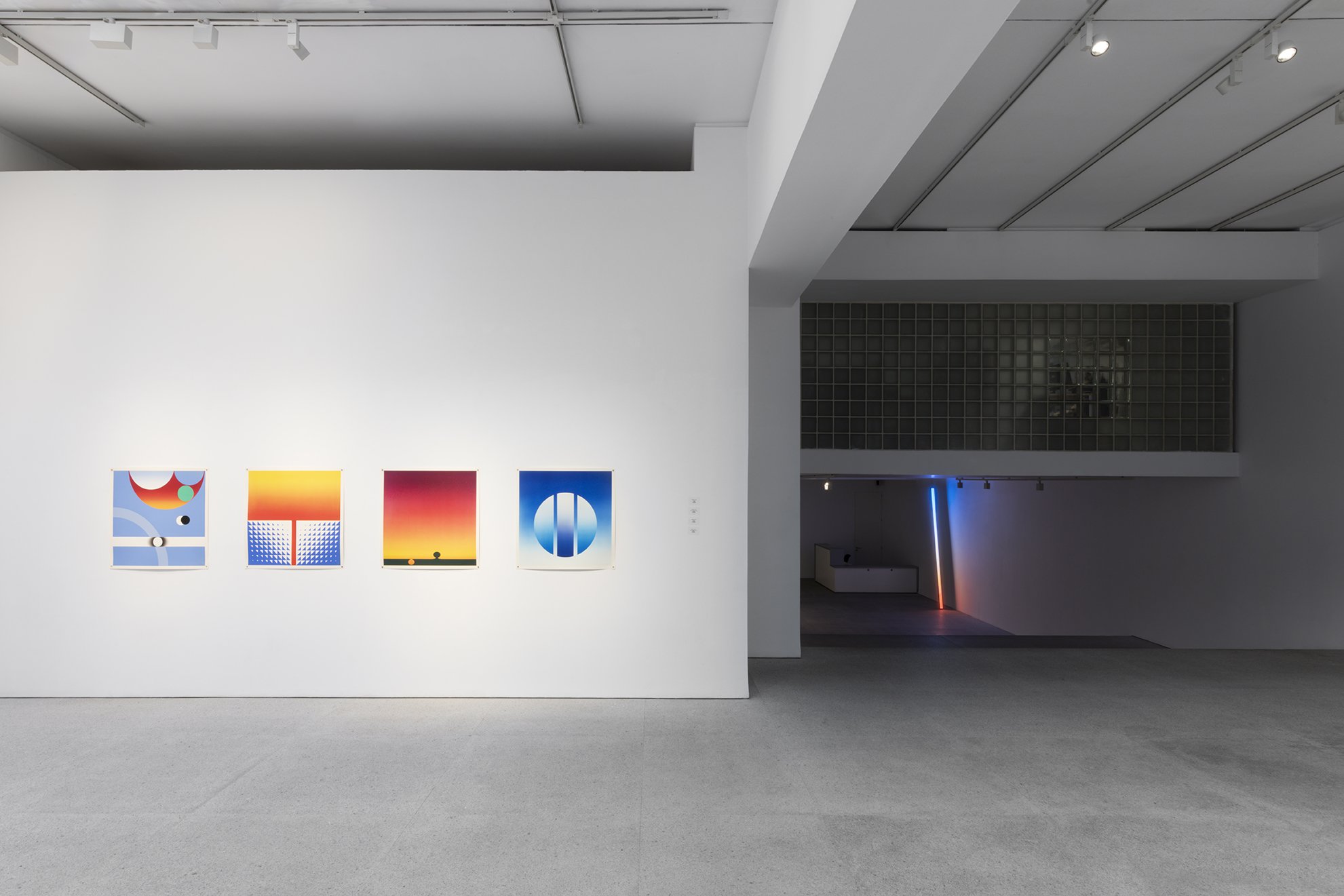

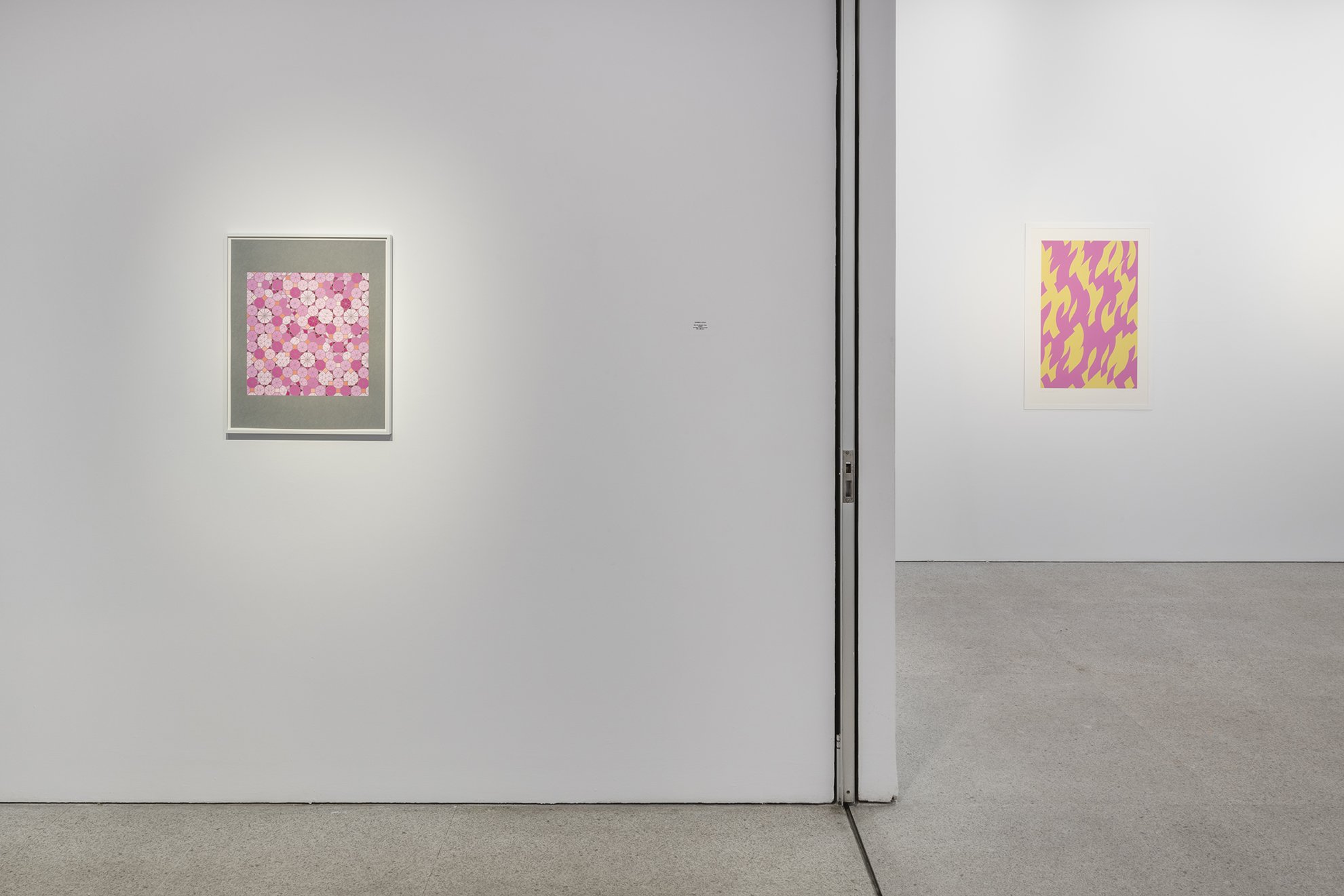
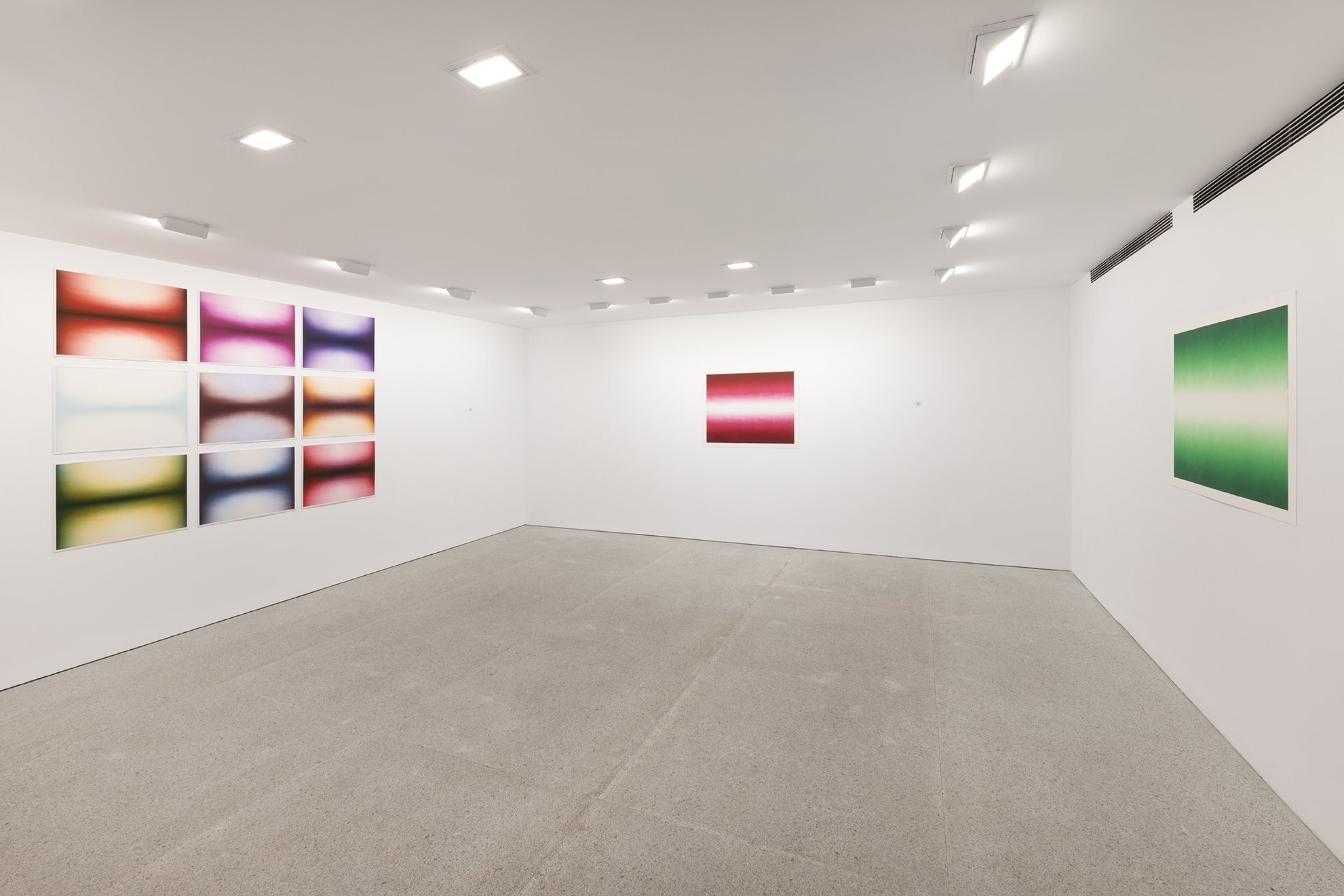



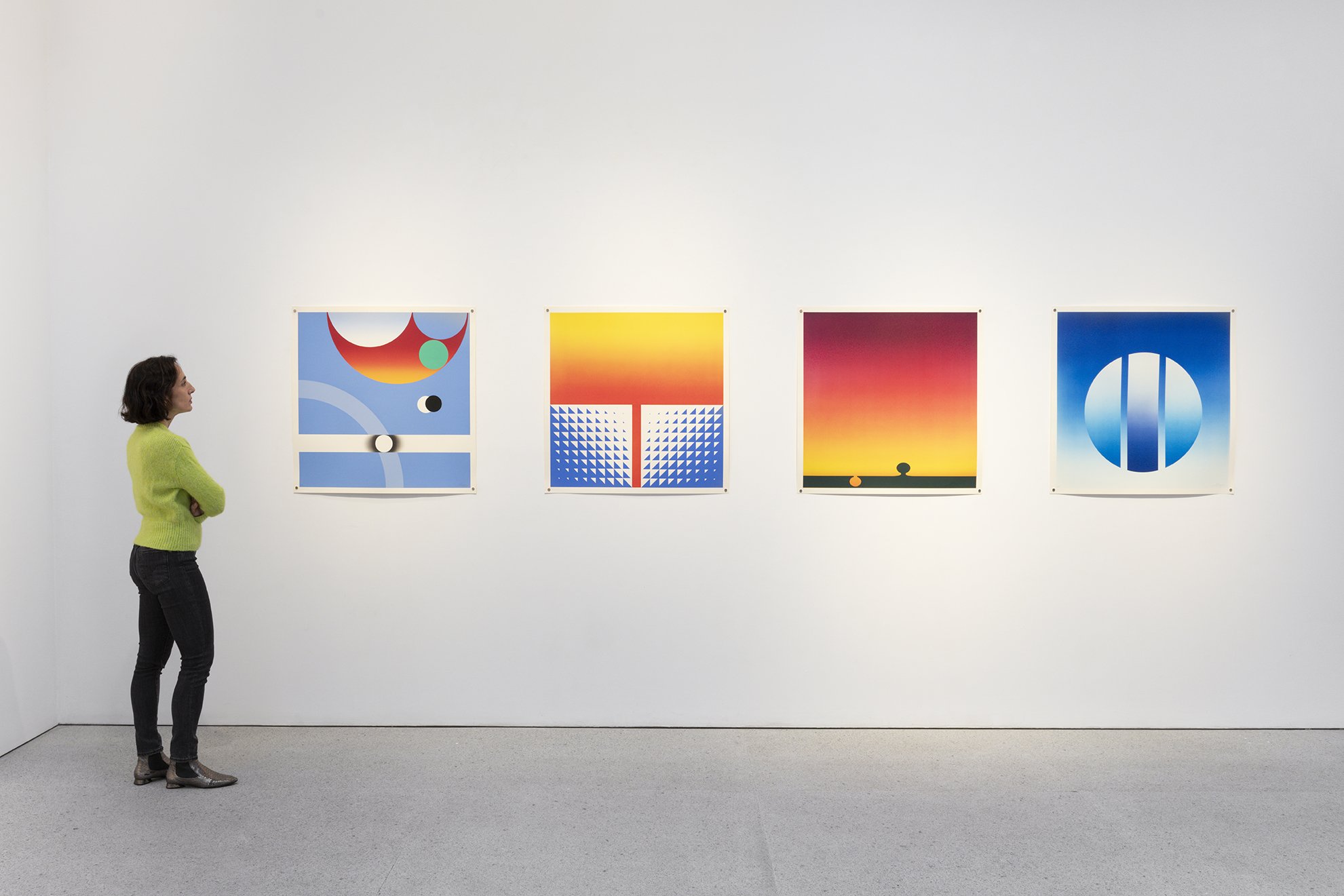
Installation views: “calor COLOR,” Galería de arte Marlborough Madrid, Spain, 2023, courtesy of Galería de arte Marlborough Photo Credit: Roberto Ruiz
To equate calor with color moves us away from a retinal approach and brings us closer to a bodily activity common to spaces of fantastic vivacity in which color is presented in a lively manner. Defending such a sense of color does not mean to state categorically that color is this or that. In order to avoid something as common in color theory as the tendency to relate shades of color to everyday objects or materials, thus blurring their true chromatic singularity, we have chosen to favor abstraction in the selection of the works. The aim is to examine the postulates of the artists present in this exhibition in relation to color, rather than favoring figuration.
The first selection of works will establish a conversation within the field of Op- art between Bridget Riley (UK, 1931) and the scientist and artist Adrien Lucca
(France, 1983). The latter specializes in the study of color with works that play with the spectrum of light to produce visual effects. His practice seeks to challenge the idea that vision is synonymous with knowledge: his works explore the limits of visual perception. Riley’s perspective, on the other hand, makes use of flat colors that play with allusions to a new landscape. The artist challenges the viewer in subtle and provocative visual experiments through optical calculation and regularities of line and color combinations. Although they belong to different generations, the plastic exercises of both artists converge in their willingness to serve scientific studies.
A second space presents a solo exhibition of the graphic work of Anish Kapoor (India, 1954) which explores in a chromatic way a mystical mood, a ceremonial and ritualistic impulse. Through his works we will try to take in his specific use of color by means of opposites to create shadows.
In addition to these proposals, there is a group exhibition with graphic works by Herbert Bayer (Austria, 1900 - United States, 1985), Piero Dorazio (Italy, 1927 - 2005), Beverly Pepper (United States, 1922 - India, 2020) and Jesús Rafael Soto (Venezuela, 1923 - France, 2005) from a specific period: 1966 to 1975. These years represent the true creative ferment around color: one of the main events was the arrival of color in television in the mid-sixties. In the artistic sphere, marked by Clement Greenberg’s defense of the reflexive flatness of color field painting, which eventually led artists to dematerialize the object, many movements and styles with color as a central impulse gained strength: pop art, optical art and minimalism are good examples.
Finally, a dialogue will be presented between the sculptors Lucas Simões (Brazil, 1980) and Blanca Muñoz (Spain, 1963), with pieces in which color is manifested through electrolysis, an electrochemical process that changes the color of metals. The Spanish sculptor works with metal and achieves iridescent results; the Brazilian, trained in architecture and urbanism, imagines forms that allow him to explore the material. Two generations united in the use of electricity as a means of tracing the change of color and its evocations.
Artist Bio:
Anish Kapoor
Anish Kapoor. Courtesy of Adam Berry
Anish Kapoor (India, 1954) is one of Britain's most celebrated artists and is considered one of the most influential sculptors of his generation. Although his artistic training took place in the UK, his work continues to draw on the richness and depth of Indian history and culture, in combination with other mythologies of the ancient world, such as Egyptian, Greek and Roman, as well as aspects of modernity.
His graphic work is characterized by the representation and transformation of hallucinatory qualities with unique and vivid colors, sometimes involving pure gradations around simple, squared or circular shapes; he also creates rich and suggestive explorations whose origins and meaning are appealing, but almost never literal or obvious.
Horizon Shadow, Untitled 03, 2010, aguafuerte, ed. de 35, 65 x 49 cm
His recent solo exhibitions include those held at: Fundación Proa, Buenos Aires; Museum of the Central Academy of Fine Arts and Imperial Ancestral Temple, Beijing; CorpArtes, Santiago de Chile; Museo Serralves, Porto; Public Art Fund, Brooklyn; MAST Foundation, Bologna; Museo Universitario Arte Contemporáneo, Mexico City; Château de Versailles; and The Jewish Museum and Tolerance Center, Moscow. His work is present in the permanent collections of the most important cultural institutions in the world, such as: Tate Gallery, London; MoMA, New York; Museo Nacional Centro de Arte Reina Sofía, Madrid; Stedelijk Museum, Amsterdam; Fundación Banco Santander; Museo Guggenheim Bilbao; and Fundación “la Caixa”, just to mention a few.
Lucas Simões
Lucas Simoes. Courtesy of the artis
The exploration of material as a form of expression in the work of Lucas Simões (Brazil, 1980) is an investigation that aims to sustain the artistic object with meaning. His training as an architect, in which technique and poetics are deeply interrelated, offers the keys to understanding his artistic production. Painting, cartography, books, photography, steel, and paper are common objects in his practice. Simões finds his means of expression in daily experimentation with materials and technical knowledge, as in his recent concrete sculptures and installations, a reflection of his research into brutalist architecture and the failure of its utopian sense.
dormente 22, 2023, acero carbono galvanizado, 73 x 34 x 17 cm
Simões has exhibited at cultural institutions around the world such as: ARCO Madrid; Casa Triângulo in São Paulo; Blouin Division in New York; Arsenal Contemporary Art in Montreal; Oscar Niemeyer Museum in Curitiba; CAAC in Seville; Museum of Contemporary Art in São Paulo; Zacheta National Gallery in Warsaw; Astrup Fearnley Museum in Oslo; Itochu Aoyam Art Square in Tokyo; and Maison Européenne de la Photographie in Paris. His work is present in numerous collections such as: Museu de Arte do Rio de Janeiro; Museu de Arte Contemporânea da cidade de São Paulo; Coleção ITAÚ de fotografia brasileira de São Paulo; Blanton Museum of Art de Austin; Centro Cultural São Paulo; Instituto Figueiredo Ferraz de Ribeirão Preto; and Fundación Kablanc de Otazu; among others.
Blanca Muñoz
Blanca Muñoz. Courtesy ©Sergio Moya
Blanca Muñoz (Madrid, 1963) graduated in Fine Arts at the Complutense University of Madrid and throughout her career has received scholarships from the Italian Government at the Calcografia Nazionale, the Royal Academy of Spain in Rome and the Directorate of Foreign Relations of Mexico. She has received, among other awards, the National Engraving Prize in 1999 and is a member of the Real Academia de Bellas Artes de San Fernando. Among her best-known monumental sculptures are the sculptural trio GORGONAS and the LUSTRAL fountain in the Plaza de España in Madrid; Altiva, in the Masaveu Foundation in Madrid; Talismán in Banca March, Madrid; Géminis, in Norman Foster’s Cepsa Tower, Madrid; Panta rei, in Málaga; Eclíptica, in the Palacio de Congresos in Badajoz; and Perseidas II, in the Parque de la Curva de Elorrieta, in Bilbao.
Romboidal. 2021. Acero inoxidable. 70 x 56 x 28 cm
Her work has been exhibited individually on several occasions at the Marlborough Gallery in New York, Madrid and Barcelona; at the Real Academia de Bellas Artes de San Fernando in Madrid; at Galerie MiniMasterpiece, Paris; at the Sala Alcalá 31 in Madrid; and at the International Biennial of Graphic Arts in Ljubljana, among others. In addition, her work has been exhibited at the Biblioteca Nacional, the Museo Nacional Centro de Arte Reina Sofía, the Museo Nacional del Prado, the Fundación Enaire, the Fundación Juan March, the Museo Würth, and the National Museum of Women in the Arts in Washington, among many other cultural institutions.
Her work is present in numerous art collections: Banco de España, Biblioteca Nacional, Colección Würth Alemania, Fundación Bancaja, Fundación María Cristina Masaveu Peterson, La Quinta Colorada in Mexico City, Museo de Bellas Artes de Álava, and Museo Nacional del Prado, among others.
Adrien Lucca
Adrien Lucca. Photo Leslie Artamonow.
Adrien Lucca (France, 1983) studied visual arts at the École de Recherche Graphique in Brussels, where he experimented with various media, including drawing on Steinbach paper. There followed an intense period of research and study of the theories of physicists and chemists such as Michel-Eugène Chevreul, Hermann von Helmholtz, Ogden Rood, Georges Roque, Françoise Viénot and Mark D. Fairchild for their recent research in the science of color.
Adrien Lucca’s interest in optical mixing led him to produce scientific drawings which he called Études. In 2010 and 2011 he continued his research at the Department of the Jan van Eyck Academy in Maastricht, and in 2014 he learned computer coding to create more complex drawings. Entirely handmade, he generated his drawings using algorithms that he designed himself based on a set of deterministic rules.
Entrelacs quisicristallins, 2016, vidriera, 60 x 192 x 5 cm
In 2019 he received a grant from the Belgian National Fund for Scientific Research to develop white light synthesizers and integrate the use of artificial light into his work. His experience with glass began in 2015, when he entered a competition organized by Bruxelles Mobilité for which he created a set of fourteen backlit stained-glass windows for the Place d’Armes metro station in Montreal. Since then, glass has become one of his favorite materials.
Adrien Lucca teaches at the Ecole Nationale Supérieure des Arts Visuels de La Cambre in Brussels. He is currently continuing his research on the complex relationship between color and light. In 2023, Lucca held his first monographic exhibition in a contemporary art museum, at the BPS22 in Charleroi, Belgium. Since 2015 he has produced monumental works in Belgium, Canada, Italy, and the Netherlands.
Bridget Riley
Bridget Riley. Photo Credit: Christian Wickler
Bridget Riley (UK, 1931) studied at Goldsmiths College and the Royal College of Art with Peter Blake and Frank Auerbach. The work of Jackson Pollock and futurism stimulated the development of what would become her signature style, Op Art, as well as her studies of pointillism and the black and white geometry of Italian Romanesque architecture. Throughout her career, her graphic work, produced by means of silkscreen printing, has sometimes anticipated her pictorial work and at other times mirrored it. Her geometric compositions seem to be full of optical effects, created with the utmost precision so that the viewer experiences both comfort and conflict.
Her work has been exhibited in international museums such as: MoMA, New York; Venice Biennale, where she won the International Painting Prize, the first woman artist to do so; Musée d’Art Moderne, Paris; National Gallery, London; National Gallery, Prague; Kunsthalle, Nuremberg; and Tate Modern, London. In addition, her work can be found in public collections around the world, including: Centre Pompidou, Paris; Dallas Museum of Art; Museum of Contemporary Art, Los Angeles; MoMA, New York; Staatsgalerie, Stuttgart; and Tate Modern, London, among many others.
Herbert Bayer
Herbert Bayer
Herbert Bayer (Austria, 1900 - United States, 1985) was a graphic designer, typographer, painter, photographer, sculptor, art director, environmental and interior designer, and architect who, using the technique of collage and photomontage, combined different images and forms on a plane that was no longer that of traditional photography, but constituted a “new reality”. The result of his work are intriguing pieces with multiple readings that evoke dadaism and surrealism.
Bayer studied at the Artists’ Cologne in Darmstadt, where he became interested in Walter Gropius’s Bauhaus manifesto. He attended the Bauhaus in Weimar, where he studied with masters such as Wassily Kandinsky, Paul Klee and László Moholy-Nagy, and was probably the most talented typographer of those who passed through the German school, although his work also encompasses painting and, above all, photographic collage. At the Bauhaus, Bayer developed a sharp visual style and adopted a sans serif (grotesque) font used in lower case for all the Bauhaus publications he designed. In 1928, Bayer left the Bauhaus to become art director of the Berlin office of Vogue magazine.
Afterglow, 1975, serigrafía, ed. de 50, 81.3 x 81.3 cm.jpg
In 1937 he set sail for the United States and from then on introduced the avant-garde of European design to North America. Bayer’s work has been exhibited at: Centre Georges Pompidou, Paris; Harvard Art Museums; MoMA, New York; ARCO Center for Visual Art, Los Angeles; and Germanisches Nationalmuseum, Nuremberg. His work is included in prominent public and private collections such as: MIT List Visual Arts Center, Whitney Museum, Guggenheim Museum, and MoMA, New York City, among many others. Bayer is also noted for monumental works such as the Mill Creek Canyon Earthworks, an environmental sculpture located in Kent, Washington.
Piero Dorazio
Piero Dorazio (Italy, 1927 - 2005) studied architecture and in the late 1940s became active in various artistic and literary circles where he met Jean Arp, Georges Braque, Sonia Delaunay, Le Corbusier, Gino Severini, Antoine Pevsner, and Georges Vantongerloo and came into contact with the School of Paris, constructivism and Italian futurism. Dorazio rediscovered the art of Giacomo Balla, who became a major influence, and became active in design, silkscreen printing and furniture design. In 1950, a visit to Paris led him to collaborate with several fellow artists in the organization of a remarkable avant-garde cooperative gallery, L’Age d’Or. While travelling in Europe and visiting New York, Dorazio developed his color-based artistic approach which, a decade later, would consolidate his international fame with works primarily concerned with color field studies and lyrical abstraction.
Fragments Frontales, 1966, litografía, ed. de 90, 63.5 x 88.9 cm
In 1953, Dorazio travelled to the United States and presented his first solo exhibitions at the Wittenborn One-Wall Gallery and the Rose Fried Gallery in New York. Dorazio exhibited at the Musée d’Art Moderne in Paris, the Albright-Knox Art Gallery in Buffalo and the Galleria Nazionale d’Arte Moderna e Contemporanea in Rome. He also participated in important international exhibitions, such as the Venice Biennale, where he exhibited in 1960, 1966 and 1988. In the following years he received private and public commissions, such as the creation of mosaics in underground stations throughout Rome.
His work is present in important collections such as: MoMA, New York; Tate Gallery, London; Centre Georges Pompidou, Paris; Peggy Guggenheim Collection, Venice; Galleria Nazionale d’Arte Moderna e Contemporanea, Rome; Museo del Novecento, Milan; Galleria Civica d’Arte Moderna e Contemporanea, Turin; National Gallery of Art, Washington; Hirshorn Museum and Sculpture Garden, Washington; Art Institute of Chicago; and Fine Arts Museums, San Francisco.
Beverly Pepper
Bevery Pepper, Courtesy Marlborough Gallery London
Beverly Pepper (United States, 1922 - Italy, 2020) began her training as a painter with Fernand Léger and André Lhote in Paris. After a trip to the temple of Angkor Wat in Cambodia, she also turned to sculpture and, together with David Smith and Alexander Calder, participated in the historic exhibition Sculture Nella Cittá in the city of Spoleto. In addition to a lifetime of gallery exhibitions, she has had numerous solo shows in museums, including MoMA, New York; Albright-Knox Art Gallery, Buffalo; Brooklyn Museum; San Francisco Museum of Art; and Ara Pacis, Rome. She is also known for her land-art works and monumental iron sculptures in the United States, Europe, and Asia. Before her death in 2020, she completed work on Beverly Pepper Park, the world’s first monothematic park of contemporary sculpture.
Blue, Silver and Yellow, 1968, repetición de papel collage con impresión, ed. de 60, 49.2 x 70.8 cm
Pepper’s works are present in major museums around the world, including: Centre Georges Pompidou, Paris; Corcoran Gallery of Art, Washington, D.C.; Dallas Museum of Art; Galleria Nazionale d’Arte Moderna, Rome; Hirshhorn Museum and Sculpture Garden, Washington, D.C., the Metropolitan Museum in New York, the MACBA in Barcelona, Spain; the Museum of Contemporary Art Chicago; the Museum of Modern Art in Sapporo, Japan; the Walker Art Center in Minneapolis; the IVAM in Valencia, Spain; and the Whitney Museum of American Art in New York.
Jesús Rafael Soto
Jesus Rafael Soto. Foto Raphael Gaillarde.
Jesús Rafael Soto’s (Venezuela, 1923 - France, 2005) quest for aesthetic representation of the immaterial and general rejection of figurative and traditional geometric form not only led to a prolific career marked by ingenuity and success, but also to the presentation of an entirely new and interactive experience for the viewer of his kinetic works. Trained at the Escuela de Artes Plásticas y Artes Aplicadas in Caracas, Soto found his formative inspiration in the Parisian avant-garde of the 1950s, moving to Paris and interacting with Jean Tinguely, Victor Vasarely, Yaacov Agam and many others associated with the Salon des Realités and the Galerie Denise René. He would also claim the optical artists Kazimir Malevich, Yves Klein and Piet Mondrian as vital to his creative process because of their complete disregard for the “object” in favor of an exploration and materialization of the ephemeral, such as Malevich’s White on White.
Soto rebelled against the limitations of two- and three-dimensionality, as well as color theory, and succeeded in creating his own stylistic methodology, involving the viewer through a mixture of media, shifting pictorial planes, scale, and color.
He has recently had solo exhibitions at: Louis Vuitton Beijing Culture and Art Space in Beijing, Centro Cultural BOD in Caracas; Hispanic Society Museum & Library in New York; and the Villa Datris Foundation in Paris.
Numerous works by Jesús Rafael Soto are in the collections of: MoMA, New York; Solomon R. Guggenheim Museum, New York; Tate Gallery, London; Stadelijk Museum, Amsterdam; Museum Boymans-van Beuningen, Rotterdam; Royal Museum of Fine Arts, Belgium; Museo Nacional de Bellas Artes, Buenos Aires; Musée d'Art Moderne, Paris; and Hara Museum of Contemporary Art, Tokyo.
The exhibit will conclude on the 27th of January next year. Please visit the Gallery’s website for more information.








